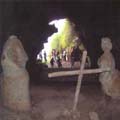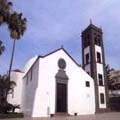History.
 El Sauzal owes its name to the abundance of willow trees growing among the springs that flow about the place.
El Sauzal owes its name to the abundance of willow trees growing among the springs that flow about the place.
From the many archaeological discoveries made, it can be concluded that El Sauzal had an important place in pre-Hispanic Tenerife, an example of this is the Cave of the Old ( Cueva de los Viejos), a guanche dwelling located on a fold of the cliffs.
Due to the London plague epidemic of 1572 El Sauzal became the political and administrative centre of the island, establishing a Chapter House in the parochial church of San Pedro.
In the XIX century, after the Courts of 1812, its guildhall was established, even though since 1676, the existence of a royal alderman was proven in El Sauzal.
A new settlement was established in the area, where in 1515, the Queen ordered a church built, the one of San Pedro Apostle, whose first parish priest was Sebastian Bello, brother of Alonso, the town founder.
Places of Historical Interest
Casona de la Baranda del Vino. XVII century (restored)
Cave of the Old (Cueva de Los Viejos) – Los Angeles
Guanche archaeological discoveries have been made in this cave. In its interior are two human figures from the XX century. Today it is not open to visitors since the new owner has cut off access to it.
Temple of Our Lady of Los Angeles. 1505.
Built by Alonso Fernández de Lugo at the beginning of the XVI century. Baroque altarpiece.
Lavatory Park (Parque de Los Lavaderos)
 Ancient meeting place of the municipality’s women, who frequented the place in order to wash clothes.
Ancient meeting place of the municipality’s women, who frequented the place in order to wash clothes.
Archaeological guanche fields on the coast
Church of San Pedro Apostle
Temporary site of Tenerife’s Chapter House due to a plague epidemic that struck La Laguna. Images of San Sebastian appear, from the XVI century, paintings: Picture of Animas, La Candelaria, a baroque silver shrine from La Laguna’s silversmiths and a San Miguel and San Rafael, as well as a neoclassic Italian baptismal basin.